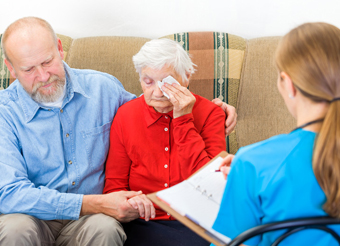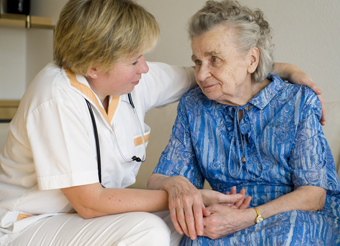 Geriatric patients usually have complex health needs and complex therapeutic regimens, requiring medical services and support from a wide variety of providers and caregivers. Transitional care includes a wide variety of services to support safe and timely geriatric patient transfer between levels of health care and across care settings. As these patients move frequently within health care settings, coordinating their care can be challenging. While medical transcription services are available to document geriatric transitions in care, proper communication and complete transfer of information is necessary to ensure continuity of care. A study published by the Journal of the American Geriatrics Society in 2017 reported that a quality improvement intervention using geriatric-specific note templates, housestaff training, and reminders could improve documentation of geriatric assessments during transitions of care.
Geriatric patients usually have complex health needs and complex therapeutic regimens, requiring medical services and support from a wide variety of providers and caregivers. Transitional care includes a wide variety of services to support safe and timely geriatric patient transfer between levels of health care and across care settings. As these patients move frequently within health care settings, coordinating their care can be challenging. While medical transcription services are available to document geriatric transitions in care, proper communication and complete transfer of information is necessary to ensure continuity of care. A study published by the Journal of the American Geriatrics Society in 2017 reported that a quality improvement intervention using geriatric-specific note templates, housestaff training, and reminders could improve documentation of geriatric assessments during transitions of care.
Studies have found that poor “handoff” of older adults and their family caregivers from hospital to home can lead to adverse events, low satisfaction with care, and high rehospitalization rates. The factors that cause gaps in care during critical transitions are:
- Poor communication
- Incomplete transfer of information
- Insufficient education of older adults and their family caregivers
- Restricted access to essential services
- Lack of a single point person to ensure continuity of care
- Cultural differences and language and health literacy issues
The geriatric assessment is a multidimensional, multidisciplinary diagnostic tool meant to collect data on the medical, psychosocial and functional capabilities and limitations of elderly patients. Comprehensive geriatric assessment, according to ocw.tufts.edu, would cover the following aspects:
- Current symptoms and illnesses and their functional impact
- Current medications, their indications and effects
- Relevant past illnesses
- Recent and impending life changes
- Objective measure of overall personal and social functionality
- Current and future living environment and its appropriateness to function and prognosis
- Family situation and availability
- Current caregiver network including its deficiencies and potential
- Objective measure of cognitive status
- Objective assessment of mobility and balance
- Rehabilitative status and prognosis if ill or disabled
- Current emotional health and substance abuse
- Nutritional status and needs
- Disease risk factors, screening status, and health promotion activities
- Services required and received
Transitions of care for the geriatric patient in the emergency department, for example, require documentation of vital information such as the reason for transfer, vital signs, code status, medication lists, and baseline mental status. But these elements are often missing in the documentation, according to a study published in Clinical Geriatric Medicine. Failed transitions are regularly blamed for major morbidity and mortality, caused by issues such as medication errors, adverse drug events, lack of timely coordination, follow-up care, and unnecessary rehospitalizations.
Researchers from the University of North Carolina at Chapel Hill evaluated a continuous quality improvement intervention aimed at improving assessment and documentation of function, cognition, and advance care planning (ACP) in admission and discharge notes on an Acute Care of the Elderly unit at an academic tertiary hospital.
The study found that at baseline, admission and discharge notes did not meet minimum documentation criteria for the three domains of function, cognition, and ACP. Moreover, documentation of function and cognition was completely absent.
The researchers found that, after the intervention, there was substantial improvement in all measures, with 64 percent of admission notes and 94 percent of discharge notes meeting at least minimum documentation criteria in all three domains. The intervention involved: introduction of templated notes, housestaff education, leadership outreach, and posted reminders.
- Templated notes: Part of the medical record, clinical notes record details of the patient’s clinical status or progress during the course of a hospitalization or over the course of outpatient care. The SOAP (subjective, objective, assessment and plan) format promotes a standard method for providing patient information, both for writing notes and presenting patients on rounds. Most electronic medical records (EMRs) have templates that present information in the SOAP note format.
- Housestaff education: Housestaff education can improve patient-centered care during care transitions by improving the rate and quality of patients ACP documentation. For instance, student-led University of California San Francisco (UCSF) Department of Medicine projects found that housestaff education resulted in an increase in ACP EMR documentation at discharge, from less than 20% of discharges to over 85% of discharges, and that the improvement was sustained over the final 8 months of the academic year. One program targeted the completion of 3 essential elements of the After-Visit Summary (AVS)– the principal diagnosis, follow-up information, and patient instructions regarding medications, return precautions, and follow-up needs at the time of discharge. The project was successful and 82% of patients discharged from UCSF received a high-quality AVS.
 Leadership outreach: Members of the geriatric health care team–nurses, physicians and other healthcare professionals–need to work together to maintain seniors at their highest level of function, improve independence, and minimize hospital visits. Outreach staff needs special training in geriatrics as well as extensive knowledge of community resource Nurses will need to develop leadership skills and competencies to work as full partners with physicians and also reach out to older adults who may not have access to health services.
Leadership outreach: Members of the geriatric health care team–nurses, physicians and other healthcare professionals–need to work together to maintain seniors at their highest level of function, improve independence, and minimize hospital visits. Outreach staff needs special training in geriatrics as well as extensive knowledge of community resource Nurses will need to develop leadership skills and competencies to work as full partners with physicians and also reach out to older adults who may not have access to health services.- Posted reminders: EMR reminders can improve care transitions for elderly patients. Many elderly patients do not receive the recommended preventive care, acute care and care for chronic conditions. The researchers found that EMR reminders promoted documentation of function, cognition, and care planning and improved patient assessment during transition of care.
“A quality improvement intervention using geriatric-specific note templates, house staff training, and reminders increased documentation of function, cognition, and ACP for post-acute care,” the authors concluded.
Accurate and complete documentation, such as that provided by an experienced geriatric transcription service company, would provide a comprehensive picture of the patient’s story, eliminating omissions, and reducing errors related to diagnostic uncertainty and care planning.